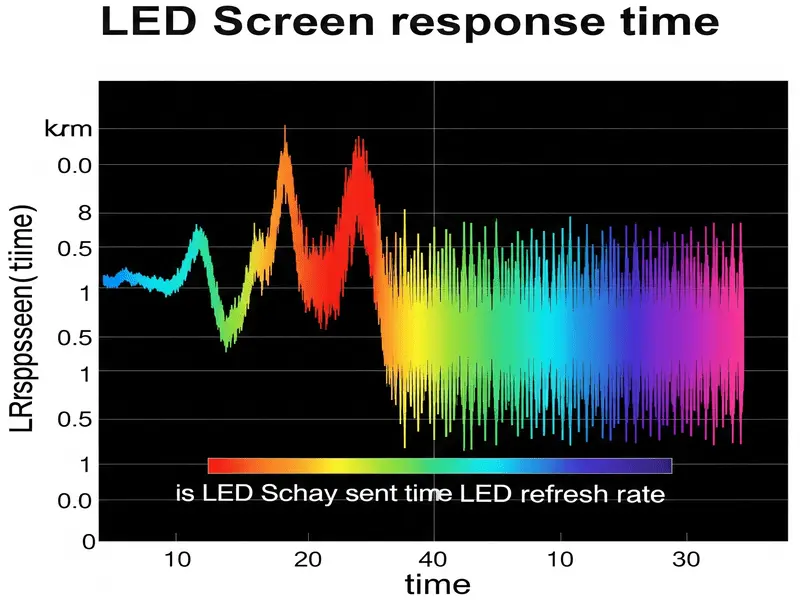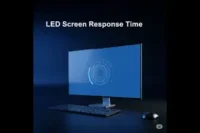The Ultimate Guide to LED Screen Response Time: Eliminate Lag, Boost Clarity & Dominate Real-Time Performance
Published: 30 Jun 2025
Introduction: Why Milliseconds Win Wars on Screen; LED Screen Response Time
In a Formula 1 race, a 5ms delay can mean missing a critical overtake. In stock trading, it can cost millions. On your gaming monitor, it means the difference between victory and defeat. LED screen response time—the time a pixel takes to change color—is the invisible force shaping these outcomes. This guide dives DEEP into the physics of light-speed displays, exposing how fast response times annihilate motion blur, how display lag reduction creates buttery-smooth interactivity, and why real-time updates demand pixel-perfect agility. Buckle up: We’re dissecting every microsecond.

Chapter 1: LED screen code – more than just “light”
1.1 What is an LED screen? (Spoiler: It’s Not OLED) ;LED Screen Response Time
LED screens use light emission diode as a backlight for an LCD panel (or as a direct emitter in Microland). Unlike Oled’s self -centered pixel, traditional LEDs depend on liquid crystals to block/remove this light. This mechanical dance determines the speed of the screen.
1.2 Reaction Time Defined: 3 Important Steps
• Gray-to-Greens (GTG): Time to switch between center-tipped (eg 50% → 80% → 50%). Most marketing measurements (eg “1ms gtg”).
• Black-to-white (BTW): Black to full infection (0% shine) white (100%).
• Black-to-black: Click Black → White → Time to cycle black. The total reset of Pixel reveals delay.
⚠ Manufacturer Chal: Brands advertise Best Case GTG (eg fastest infection), not average. The performance of the real world varies wildly.
1.3 Why response time ≠ Input interval
•LED Screen Response Time: Physical pixel transition rate (measured in MS).
• Input delay: The total delay from the input (mouse click) on the screen (processing, scanning, pixel reaction).
Example: 5ms input delay + 3ms GTG = 8ms A screen with total delay.
Chapter 2: The Quantum Physics of Speed – How LEDs Change Color
2.1 Liquid Crystal Inertia: The Speed Bottleneck
LED pixels change color via liquid crystals (LCs). When voltage is applied, LCs physically twist to modulate light. This mechanical movement has inertia—like stirring honey. Faster voltage shifts = faster twisting, but overshoot causes artifacts (more later LED Screen Response Time).
2.2 Overdrive: The “Turbo Boost” for Pixels
Overdrive (or Response Time Compensation) applies higher voltage to force LCs to twist faster. Too little? Ghosting. Too much? Inverse Ghosting (Coronas)—pixels overshoot target color, leaving bright trails.
| ✅ Pro Tip: |
|---|
Adjust overdrive settings per refresh rate (e.g., “Normal” for 60Hz, “Extreme” for 144Hz). |
2.3 The Refresh Rate Multiplier
A 144Hz screen refreshes every 6.94ms. If pixel response is slower (e.g., 8ms), frames “blend,” causing motion blur. Rule of thumb: LED Screen Response Time
Response Time (ms) ≤ 1000 / Refresh Rate (Hz)
Example: For 240Hz, aim for ≤4.16ms GtG.
Chapter 3: Fast Response Times – The Holy Grail of Motion Clarity
3.1 Gaming: Where 1ms Wins Championships
Call of Duty at 240Hz demands near-instant pixel transitions. Slow response causes:
- Ghosting: Faint trails behind moving objects.
- Smearing: Blur during panning shots.
🔥 Real-World Fix: ASUS ROG Swift PG259QNR (360Hz, 1ms GtG) uses ELMB Sync (Extreme Low Motion Blur) + NVIDIA Reflex to hit near-zero lag.
3.2 High-Frequency Trading: When µs = Millions
Traders use “ticker walls” with sub-1ms response. Slow pixels = outdated prices. Example: The Crypto.com Arena display uses 500Hz scanning for real-time stats.
3.3 Sports Broadcasting: No Blur on 100mph Fastballs
Sony’s Crystal LED VERONA series achieves 0.1ms BtW for live 8K broadcasts. Slow screens = blurry pitches.
Chapter 4: Display Lag Reduction – Syncing Brains & Pixels
4.1 The Lag Chain: From GPU to Eyeballs
Total lag = GPU Render Time + Display Processing + Scanout Delay + Pixel Response.
Fix the weakest link: LED Screen Response Time
- GPU: NVIDIA Reflex / AMD Anti-Lag.
- Processing: Enable “Game Mode” to bypass filters.
- Scanout: Use VRR (Variable Refresh Rate) like G-Sync.
4.2 VRR + Fast Response = Lag Annihilation
G-Sync/FreeSync syncs refresh rate to GPU output. Paired with fast response, it eliminates:
- Tearing (mismatched frames).
- Stuttering (uneven frame delivery).
✅ Data Point: LG 27GP850-B (Nano IPS, 180Hz) + G-Sync cuts input lag to 2.7ms.
4.3 The “Click-to-Photon” Holy Grail
Esports monitors like BenQ ZOWIE XL2566K (DyAc⁺) achieve ≤1ms input lag via:
- TN panel (fastest LED Screen Response Time).
- Dedicated scalar chip.
- Backlight strobing.
Chapter 5: Real-Time Updates – When Screens Can’t Wait
5.1 Control Rooms & Live Events
Tokyo’s Shinjuku Station uses 8mm-pitch LED walls with ≤3ms GtG. Delayed departure info = chaos.
5.2 Simulators & VR
Oculus Quest 3’s LCD hits 1ms persistence (image hold time) to prevent motion sickness. Slow response = nausea.
5.3 AI Dashboards & IoT
Tesla’s in-car displays use low-persistence LEDs so speedometer updates align with real-world acceleration.
Chapter 6: Battle of Technologies – LCD vs. OLED vs. Micro LED
| Technology | Avg. Response Time | Pros | Cons |
| LED-LCD | 1-5ms (GtG) | Affordable, bright | Backlight bleed |
| OLED | 0.1ms (GtG) | Perfect blacks, infinite contrast | Burn-in risk |
| Micro LED | ≤0.01ms (GtG) | No burn-in, modular | Extremely expensive |
✅ Gaming Pick: Fast IPS (1ms) for color accuracy.
✅ Absolute Speed: OLED (0.1ms).
Chapter 7: Buying Guide – Cut Through Marketing Lies
7.1 Key Specs Decoded
- Ignore “1ms” claims alone. Demand MPRT (Moving Picture Response Time) or GtG averages.
- Prioritize VRR support (G-Sync/FreeSync Premium). LED Screen Response Time
- Match response to refresh: 144Hz needs ≤7ms, 240Hz needs ≤4ms.
7.2 Test It Yourself
- Ghosting
- Input Lag
7.3 Top Picks (2024)
- Best All-Around: ASUS ROG Swift PG27AQN (1440p, 360Hz, 1ms).
- Budget King: Gigabyte G24F 2 (1080p, 180Hz, 0.5ms MPRT).
- Elite Speed: Alienware AW3225QF (QD-OLED, 240Hz, 0.03ms GtG).
Chapter 8: Future Tech – Chasing the Instant Pixel (Where 0ms Awaits)
Imagine a screen where the image reacts instantly – no blur, no ghosting, just pure, immediate response to your input. That’s the dream of “0ms” latency, and here’s how these technologies are pushing us there:
μLED (Micro-LED) – Like “The Wall” by Samsung: Tiny Pixels, Lightning Speed:
- The Idea: Forget traditional screens needing a separate backlight (LCD) or organic materials that wear out (OLED). μLED makes each individual pixel its own microscopic, self-powered light source – an incredibly tiny, inorganic LED.Why it’s Blazing Fast (0.01ms GtG): Since each pixel is the light emitter, changing its brightness or color is only limited by how fast electricity can make the semiconductor material light up. That physics happens incredibly quickly – we’re talking microseconds. Samsung’s measured “Gray-to-Gray” (GtG) transition – basically how fast a pixel changes shade – hits 0.01ms. That’s roughly 100 times faster than the best gaming LCDs and significantly quicker than OLED.
- The Impact: This near-instantaneous pixel switching virtually eliminates the motion blur and ghosting artifacts you see on current displays when things move fast. It’s the ultimate hardware solution for speed, promising crystal-clear motion.
- GaN (Gallium Nitride) Backlights – Supercharging LCD’s Light Switch:
- The Problem: High-end LCDs (especially Mini-LED ones) use hundreds or thousands of tiny LEDs for their backlight, divided into zones for better contrast. But the electronics controlling these LEDs (turning them on/off, dimming them) have traditionally used silicon chips, which have speed and efficiency limits. This creates a bottleneck – the backlight can’t keep up perfectly with the super-fast LCD panel or high refresh rates.LED Screen Response Time
- Why it Matters for Speed: For displays using local dimming (like Mini-LED) or techniques like Black Frame Insertion (BFI) to reduce motion blur, the backlight needs to react instantly. GaN enables that. It allows the backlight zones to pulse on and off with incredible precision and minimal delay, syncing perfectly with the panel and high refresh rates. This dramatically reduces issues like “blooming” (light bleed) and makes motion look significantly sharper on advanced LCDs.
- AI-Pixel Prediction (Nvidia’s Research) – The Display That Anticipates:
- The Bottleneck: Even with a fast panel, there’s inherent lag in the system: your GPU renders a frame, sends it over the cable, the display processes it, and then the pixels start changing. That whole chain adds milliseconds.
- The Clever Trick: Nvidia is researching using Artificial Intelligence to break this chain. Instead of waiting for the GPU to finish rendering the complete next frame, the AI analyzes the current frame, your inputs, and motion patterns. It then predicts where moving objects will be in the very next frame.
- “Pre-Shifting” Pixels: Here’s the radical part: Based on this prediction, the display controller can tell the pixels to start physically moving towards their predicted new positions before the actual final frame data arrives from the GPU! When the real frame data does show up milliseconds later, the pixels are already mostly where they need to be, requiring only minor tweaks.
- The Goal & Challenge: This AI “cheat” aims to overlap the slow pixel transition time with the GPU render and data transfer time, slashing the perceived total system latency. The big hurdle? The AI needs to be incredibly accurate. Wrong predictions could cause visual glitches that might be worse than the lag it’s trying to fix. It’s a high-risk, high-reward software approach.
Putting it Together:
These aren’t competing ideas, but potential pieces of the ultimate low-latency puzzle: LED Screen Response Time
- μLED tackles the fundamental physics of the pixel itself.
- GaN turbocharges the supporting electronics, especially for advanced LCDs.
- AI-Prediction tries to outsmart the entire rendering and display pipeline.
The future “0ms” display might combine the raw speed of μLED pixels, driven by ultra-efficient GaN circuitry, guided by intelligent AI prediction to make the whole system feel impossibly responsive. We’re not quite there yet, but these paths show how seriously the industry is chasing that instant reaction.
FAQs: Burning Questions, Lightning Answers
Q: Is 1ms response time enough for PS5?
A: Yes—but pair it with HDMI 2.1 VRR for 4K/120Hz.
Q: Can I “upgrade” my monitor’s response time?
A: Partially: Enable overdrive, disable motion smoothing, use VRR.
Q: Why do my eyes hurt on “fast” screens?
A: Overdrive set too high causes PWM flicker/coronas. Lower setting + bias lighting.
Q: OLED has 0.1ms response—why isn’t everyone using it?
A: Burn-in risk for static UIs (e.g., taskbars), higher cost.
Q: Does screen size affect response time?
A: Indirectly: Larger screens = more processing (potential lag). Prioritize panel tech.
Conclusion:
Speed Isn’t Everything—It’s the Only Thing: LED Screen Response Time
LED screen response time is the spine of visual performance. From the trader’s ticker to the gamer’s headshot, fast response times crush motion blur, display lag reduction creates telepathic control, and real-time updates demand pixel-perfect precision. Master these principles—and you master the screen. Now go dominate. 🏆

- Be Respectful
- Stay Relevant
- Stay Positive
- True Feedback
- Encourage Discussion
- Avoid Spamming
- No Fake News
- Don't Copy-Paste
- No Personal Attacks



- Be Respectful
- Stay Relevant
- Stay Positive
- True Feedback
- Encourage Discussion
- Avoid Spamming
- No Fake News
- Don't Copy-Paste
- No Personal Attacks





